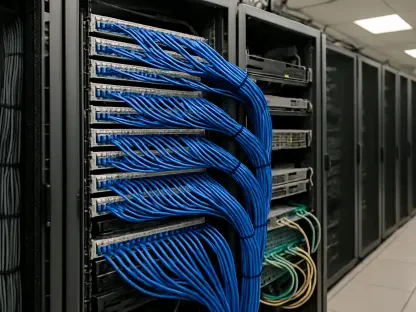In a digital landscape where cyber threats evolve at an alarming pace, a leading cybersecurity provider finds itself grappling with significant challenges that could impact countless organizations worldwide. Fortinet, a key player in network security solutions, has recently disclosed a critical vulnerability in its FortiSIEM software while simultaneously facing a sharp increase in brute-force attacks targeting its SSL VPNs. This dual threat underscores the persistent risks associated with edge technologies, which serve as gateways to organizational networks. As attackers increasingly focus on exploiting vulnerabilities in VPNs and firewalls, the urgency for robust defense mechanisms has never been clearer. This situation not only highlights specific issues within Fortinet’s ecosystem but also reflects broader trends in cybersecurity, where the intersection of severe flaws and targeted campaigns can create a perfect storm for breaches.
Emerging Threats in Fortinet’s Ecosystem
Critical Vulnerability in FortiSIEM Software
A severe security flaw in Fortinet’s FortiSIEM platform, identified as CVE-2025-25256, has raised significant concerns among cybersecurity professionals due to its potential for devastating impact. With a CVSS score of 9.8, this OS command injection vulnerability allows unauthenticated attackers to escalate privileges and execute malicious code or commands, posing a critical risk to affected systems. While there is no confirmed evidence of active exploitation at this time, Fortinet has issued a stark warning about the existence of “practical exploit code” in the wild. This lowers the barrier for attackers, including those with limited technical expertise, to weaponize the flaw. The company has strongly advised customers to update to the latest software versions and, as a temporary safeguard, restrict access to the phMonitor port (7900). Complicating matters further, the exploit code leaves no clear indicators of compromise, making it exceptionally difficult for defenders to detect and respond to potential intrusions.
The implications of this vulnerability extend beyond immediate technical concerns, as it highlights the challenges organizations face in securing complex security information and event management systems. FortiSIEM is designed to provide critical visibility into network activities, and a breach at this level could compromise an organization’s entire security posture. Fortinet’s advisory emphasizes the stealthy nature of potential attacks, meaning that even vigilant teams might miss signs of exploitation until significant damage has been done. Historical data from cybersecurity agencies shows that flaws of this magnitude often become targets for ransomware and other malicious campaigns shortly after disclosure. As such, the urgency to patch and mitigate cannot be overstated. Organizations relying on FortiSIEM must prioritize swift action to prevent attackers from leveraging this vulnerability as an entry point into broader network environments, where the consequences could be catastrophic.
Surge in Brute-Force Attacks on SSL VPNs
Concurrently with the FortiSIEM vulnerability disclosure, a notable spike in brute-force traffic targeting Fortinet’s SSL VPNs has been observed, adding another layer of concern for users of these widely deployed solutions. Reports from threat intelligence sources indicate that over 780 unique IP addresses have engaged in deliberate attempts to guess credentials, focusing specifically on FortiOS profiles. Unlike opportunistic scans, this activity appears highly targeted, suggesting a coordinated effort to exploit weaknesses in VPN configurations. Although a direct connection between this surge and the FortiSIEM flaw remains unconfirmed, the timing of these events is striking. Such patterns of malicious activity often precede or coincide with the public revelation of critical vulnerabilities, amplifying the risk to organizations that may already be stretched thin in addressing multiple threats.
This wave of brute-force attacks underscores the inherent vulnerabilities of edge technologies like SSL VPNs, which are perpetually exposed to the internet and serve as critical access points to internal networks. Threat intelligence analysis reveals that spikes in such targeted activity have historically correlated with the disclosure of new CVEs within a short timeframe, with patterns suggesting malicious actors prepare for exploitation well in advance. For Fortinet users, this means heightened vigilance is essential, as attackers could be laying the groundwork for more sophisticated campaigns. The lack of immediate clarity on whether these brute-force attempts are linked to the FortiSIEM issue only adds to the complexity of crafting an effective defense strategy. Organizations must reinforce VPN security through strong authentication mechanisms and continuous monitoring to thwart credential-guessing efforts before they escalate into full-scale breaches.
Broader Implications for Cybersecurity
Persistent Risks in Edge Technologies
Edge devices such as VPNs and firewalls, including those from Fortinet, remain prime targets for cybercriminals due to their critical role in securing network perimeters and their constant exposure to external threats. The Cybersecurity and Infrastructure Security Agency (CISA) has documented numerous Fortinet vulnerabilities in its known exploited catalog, with several added over recent years and many linked to ransomware attacks. Reports from threat intelligence firms like Mandiant highlight that edge technologies harbor some of the most frequently exploited flaws, with specific Fortinet vulnerabilities ranking high in incident response cases. This trend illustrates how attackers prioritize these entry points, exploiting them often within weeks of public disclosure or the availability of exploit code, leaving organizations with little time to react.
The persistent targeting of Fortinet products reveals a broader challenge in cybersecurity: securing the very tools designed to protect networks. As edge devices act as the first line of defense, any weakness can provide attackers with direct access to sensitive systems, amplifying the potential for widespread damage. The combination of critical vulnerabilities like CVE-2025-25256 and ongoing brute-force campaigns creates a volatile environment where defenders must constantly adapt to evolving tactics. Insights from multiple threat intelligence sources emphasize that the rapid weaponization of disclosed flaws is a recurring issue, particularly for technologies integral to network security. For organizations, this necessitates a proactive approach, including timely patching, robust access controls, and enhanced monitoring to detect anomalies before they escalate into full-blown incidents.
Challenges in Detection and Mitigation
One of the most troubling aspects of the current threats facing Fortinet users is the difficulty in detecting exploitation, especially with the FortiSIEM vulnerability where indicators of compromise are notably absent. This stealthy nature of potential attacks means that traditional security measures may fail to identify malicious activity until significant harm has already occurred. Fortinet’s advisory acknowledges this challenge, urging customers to implement immediate workarounds while longer-term fixes are applied. Beyond technical responses, the situation calls for a comprehensive reassessment of how organizations monitor and protect critical systems, particularly those exposed to the internet and integral to security operations.
Compounding the detection issue is the sheer volume of threats targeting Fortinet solutions, as evidenced by the simultaneous brute-force surge against SSL VPNs. Defenders must juggle multiple risks, often with limited resources, making it imperative to prioritize based on severity and potential impact. The historical exploitation of Fortinet flaws, as documented by CISA and other entities, serves as a reminder that attackers are quick to capitalize on any opportunity. Organizations face the daunting task of not only addressing known vulnerabilities but also anticipating future threats based on emerging patterns. Strengthening defenses requires a multi-layered approach, integrating advanced threat detection tools, regular security audits, and employee training to reduce the likelihood of successful attacks. Only through such diligence can the risks posed by these persistent and evolving threats be effectively mitigated.
Securing the Future of Network Perimeters
Looking back, the dual challenges of a critical FortiSIEM vulnerability and a surge in brute-force attacks on Fortinet’s SSL VPNs painted a stark picture of the cybersecurity landscape. These incidents served as a powerful reminder of the relentless focus attackers place on edge technologies, exploiting even the smallest weaknesses to gain unauthorized access. The urgency with which Fortinet communicated the need for updates and temporary mitigations reflected the severity of the risks, while historical exploitation trends underscored the likelihood of rapid weaponization by malicious actors.
Moving forward, organizations that rely on Fortinet solutions need to adopt a proactive stance, prioritizing immediate software updates to address CVE-2025-25256 and fortifying VPN security against brute-force attempts. Implementing multi-factor authentication, enhancing network monitoring, and conducting regular vulnerability assessments emerge as critical steps to safeguard against similar threats. Beyond these immediate actions, fostering a culture of continuous improvement in cybersecurity practices becomes essential. By staying ahead of emerging attack patterns and investing in advanced threat intelligence, businesses can better protect their network perimeters from the ever-evolving tactics of cybercriminals.









